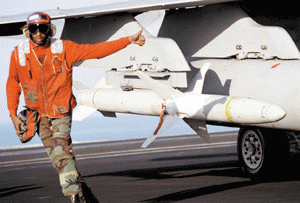AGM-88 HARM
|
|
| Primary Function: | Air-to-surface anti-radiation missile; attack and destroy hostile radar installations. |
| Contractor: | Raytheon Corporation (originally developed by Texas Instruments) |
| Power Plant: | Thiokol dual-thrust, solid-propellant rocket motor |
| Length: | 4.1m (13 ft 8 in) |
| Launch Weight: | 360 kg (800 lb) |
| Diameter: | 254 mm (10 in) |
| Wing Span: | 1.1 m (3 ft 8 in) |
| Range: | 90+ km (80+ statute miles, 57+ nautical miles) |
| Speed: | 340 m/s (760+ mph) |
| Guidance: | radar homing |
| Warhead: | Blast fragmentation; warhead weight 68 kg (150 lb) |
| Unit Cost: | US$284,000 |
| Date Deployed: | 1985 |
The AGM-88 High-Speed Anti-radiation Missile (HARM) is an air-to-surface tactical missile designed to seek out and destroy enemy radar-equipped air defense systems.
The AGM-88 can detect, attack and destroy a target with minimum aircrew input. The proportional guidance system that homes in on enemy radar emissions has a fixed antenna and seeker head in the missile's nose. A smokeless, solid-propellant, dual-thrust rocket motor propels the missile at speeds up to Mach 4.
The HARM missile was approved for full production in March 1983. It proved effective against Libyan targets in the Gulf of Sidra in 1986, and was used extensively by the Navy and the Air Force in Operation Desert Storm in 1991.

